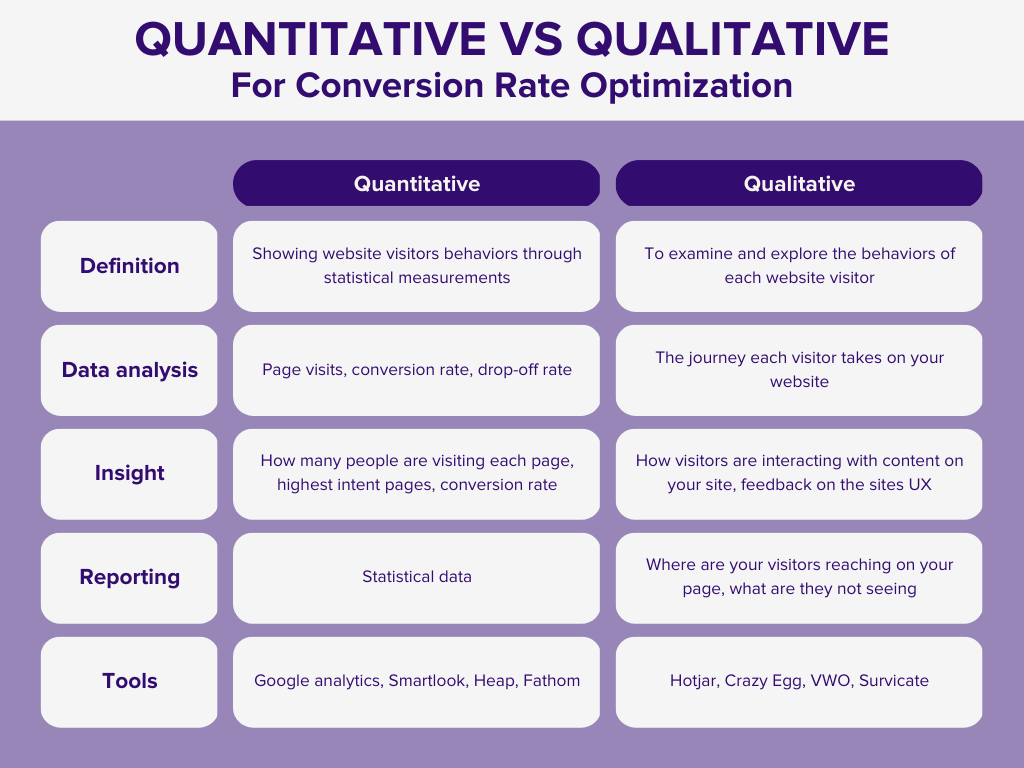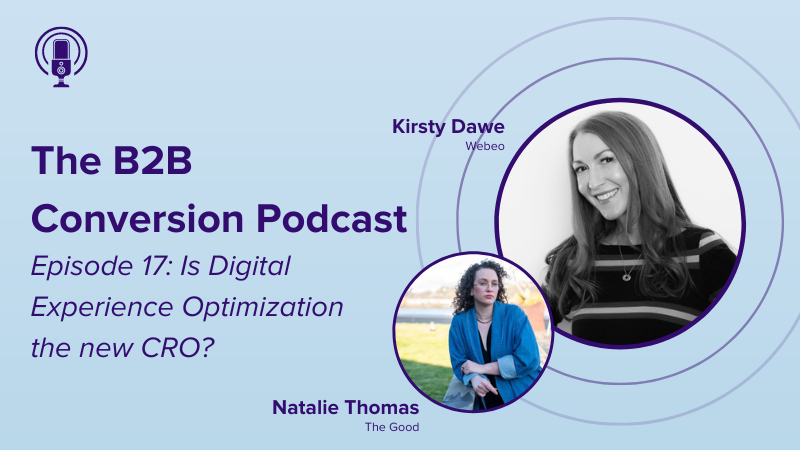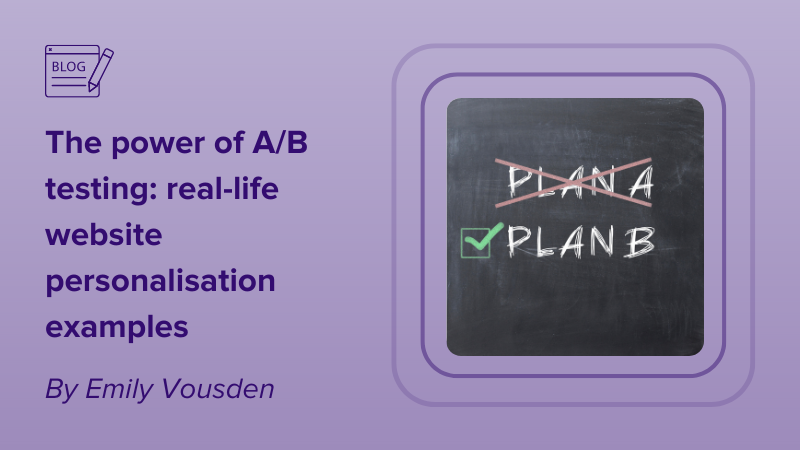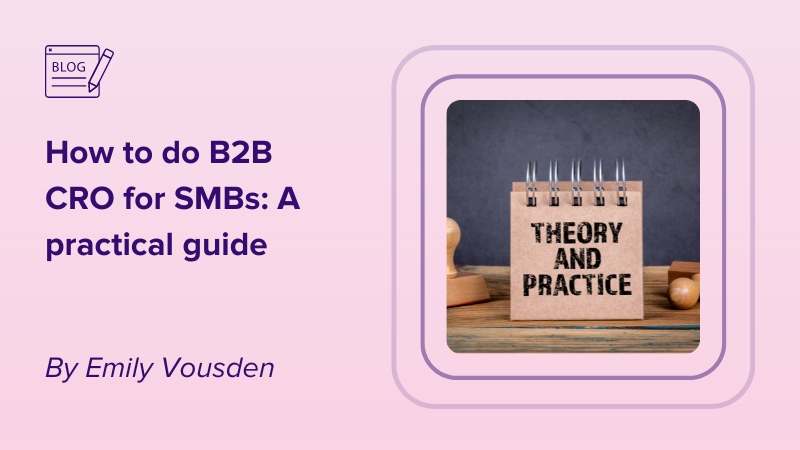By now, we know Conversion Rate Optimization is fundamental in any B2B marketing strategy. And just like any component of a marketing strategy, planning and analysis will lead marketers to solve challenges faced and deliver the results planned. Without business analysis, marketers could be working with a strategy that has no credibility, and let’s be honest, is likely to fail at the first hurdle. When adopting CRO it’s no different, B2B marketers need to look at the business analysis to help guide their decision-making, pave the correct path toward business growth, and keep competitors at bay. Let us start by recapping quantitative and qualitative analysis, the two most common types. Both are unique in the information they can uncover and when used together, will provide top actionable insight into prospect’s needs and preferences that can ultimately help B2B brands become more relevant and drive more sales.
Quantitative analysis
Quantitative is where people often start with their analysis, it’s the process of collecting and analyzing numerical data. It can be used to identify trends and patterns and, in turn, make predictions.
When focusing on CRO, quantitative analysis can help marketers track the following:
- How many visitors you’ve had on your website
- What are your most popular pages
- Where are your prospects converting the most and the least
- What pages have the highest bounce rate
- What channel is the most successful for driving new visitors
Google Analytics is a gold mine for uncovering valuable quantitative data on your website and is also a free tool for marketers, so there’s really no excuse when it comes to looking at the quantitative analysis (check out our blog for more information on where to start).
Qualitative Analysis
Qualitative analysis is the opposite of quantitative, it’s your non-numerical data which can help you understand opinions and experiences. Qualitative data is used to obtain a deeper insight into your challenges and help with generating new ideas for improvement.
When focusing on CRO, qualitative analysis can help with the following:
- Pinpointing where your visitors are losing focus or becoming frustrated
- Recognizing the biggest friction points
- Understanding visitor behavior
- Gaining visitor feedback on specific pages
Usability tests are a good place to start, ask a few members of your company to visit your website, each with a specific goal in mind (for example to find out about a specific product), then ask them for their honest feedback. Did they find the information they needed? Was the information easy to find? How did they feel about your brand? Did they know where they could get in touch with a member of your team?
If you want to get serious about Qualitative research then there are tools specifically built to analyze heat mapping and collect real visitor feedback through onsite surveys (check out our blog for more info on where to start).


Quantitative vs Qualitative
Using quantitative and qualitative analysis to make CRO decisions
Before you start, it’s worth documenting the questions you want your data analysis to answer, so you have a clear structure to your analysis. There is a lot of analysis available to prevent you from drowning in it, set clear expectations, and outline the data that will be fundamental to helping your business make better-informed decisions. Remember, the value comes from using both quantitative and qualitative data together in unison – and exposing patterns and trends across your website.
We’ve really banged the drum on the importance of experimentation when focusing on conversion rate optimization. CRO is a long game and should be made up of small, incremental changes that are delivered off the back of the data captured firsthand from your B2B website.
If you’re just starting out with CRO, we’d recommend you spend a significant amount of time digging deeper into your quantitative and qualitative data. Then, you’ll be able to formulate a strategy based on the highest impact pages, focusing on the areas that could be providing a better user experience.
Once you know the pages that have the highest drop-off (using your quantitative data), you can look into what elements of the page the visitors are drawn to (using your qualitative data). Is your main message relevant to the visitor? Is your call to action above the fold and easy to identify? It’s probably worth comparing your highest-performing pages against the pages that perform the worst to understand what quick changes you can test. It’s important to remember some pages on your website will naturally convert better than others (your product page or contact page for example), so make sure these pages have the most valuable information for your visitors.
Once you know the improvements that are needed, you can start to look at the tech that can help you.
To summarize
- Set expectations on the data you want to uncover from your analysis
- Start with quantitative analysis and define your numerical trends and patterns
- Move to qualitative data and uncover the key challenges with your website functionality
- Piece both your quantitative and qualitative data together and build a clear picture of your website experience
- Map out the changes you’d like to test in your CRO strategy (start with your highest intent pages first!)
- Use visitor feedback to make the changes
- Test your results and repeat




